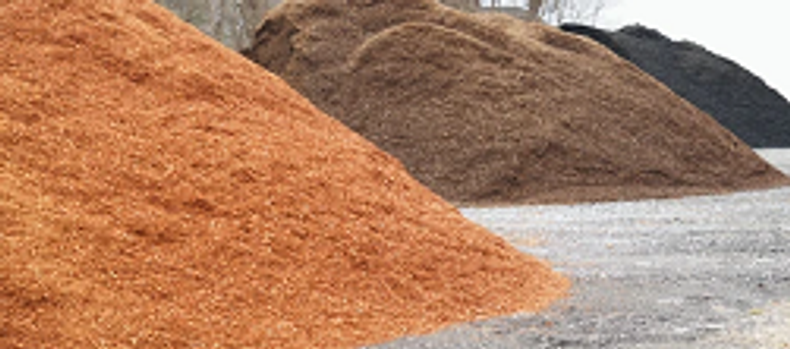Final Products in Your Wood and Yardwaste Recycling Facility– What will you make?
Before setting up a wood and yardwaste recycling facility, the questions “What products will be produced?” must be answered. This post will cover a variety of the most common marketable products in a wood and yardwaste recycling facility as well as several of the contaminants that you should expect and be prepared to handle.
Woody Materials
Landscape Mulch:
Mulch has been one of the main products of wood and yard waste recycling operations. It is a shredded product that is generally 2” or less in length, ½” or less in diameter (or width), and by volume will contain less than 10% particles as fine as sawdust. It is normally aged for a few months or until it acquires a uniform dark brown color. To make marketable mulch you need material that has been reduced in size, aged and all contaminants (plastics, metals, etc.) must be removed. Coloring the mulch, or registering it as “playground” mulch can improve profitability if you have sufficient demand in your market.
Mulch (unmarketable): I want to mention here that many customers produce an unmarketable mulch product that is used for public convenience such as landfill cover, highway right-of-ways, etc., uses that do not require uniform size or quality. Depending on the application, not all contaminants or oversized wood chips may need to be removed.
Soil Amendment:
Composting shredded wood and yard waste produces soil amendment. It is a fibrous wood product that helps improve the condition of any soil and is competitive with peat moss as a soil additive. Soil amendment particles are normally less than ½” in length, no larger than 1/16” in diameter, and are primarily fine particles similar to sand and dirt.
There are several methods of composting; in-vessel systems that require high tech equipment and a large up-front investment, and windrow composting that is basically low tech and utilizes less expensive equipment. We will only discuss the windrow composting method here.
To operate a windrow composting facility you need pre-processed raw material that has been reduced in size through the shredding and/or grinding process to particles 4” long or less that 1” diameter and less and all contaminants removed. You then need land; space for your windrows, water and a method for adding it to the windrows, a rubber tired loader for moving materials, a compost turner for aerating the windrows and a compost screen for sizing your final products.
A compost facility can be indoors or out depending on the size and location of the project. There are earthy odors associated with composting that some individuals find objectionable so find a location with adequate space around it and isolate yourself from neighbors as much as possible.
Boiler Fuel:
Waste wood particles have long been used for firing boilers in the forest industry and now many wood fired power plants have been constructed for burning waste wood generated in the municipal sector. Boiler fuel made in a recycling operation is a shredded product, normally 1” to 3” in length and ¼” to 1” in diameter. Wood fired power plants can’t accept leaves, grass or sawdust from recycling operations because these items contain too much dirt. If you want to make boiler fuel from waste wood materials you will normally be required to screen out all contaminants and remove any fines less than ¼” in size. The fines will often have a market as a low quality landscape product, and can be composted to improve the quality.
Sewage Sludge Bulking Agent:
Wood chips are an excellent bulking agent for sewage sludge composting operations. Some sludge composting facilities are deigned to use chips the same size as is used for boiler fuel but will accept them with the fines (sawdust and dirt) mixed in, other operators want just the fines and no large chips. Those facilities that use the larger chips will compost them with the sludge and then used a trommel screen to separate out whatever is left of the wood chips at the end of the compost process. The remainder of the old chips are then combined with new chips and used to form a new compost pile. This system is a cycle: old chips deteriorating away and new chips being added. Those facilities that use only sawdust as a bulking agent normally compost it all down to dirt and there is nothing left to separate.

